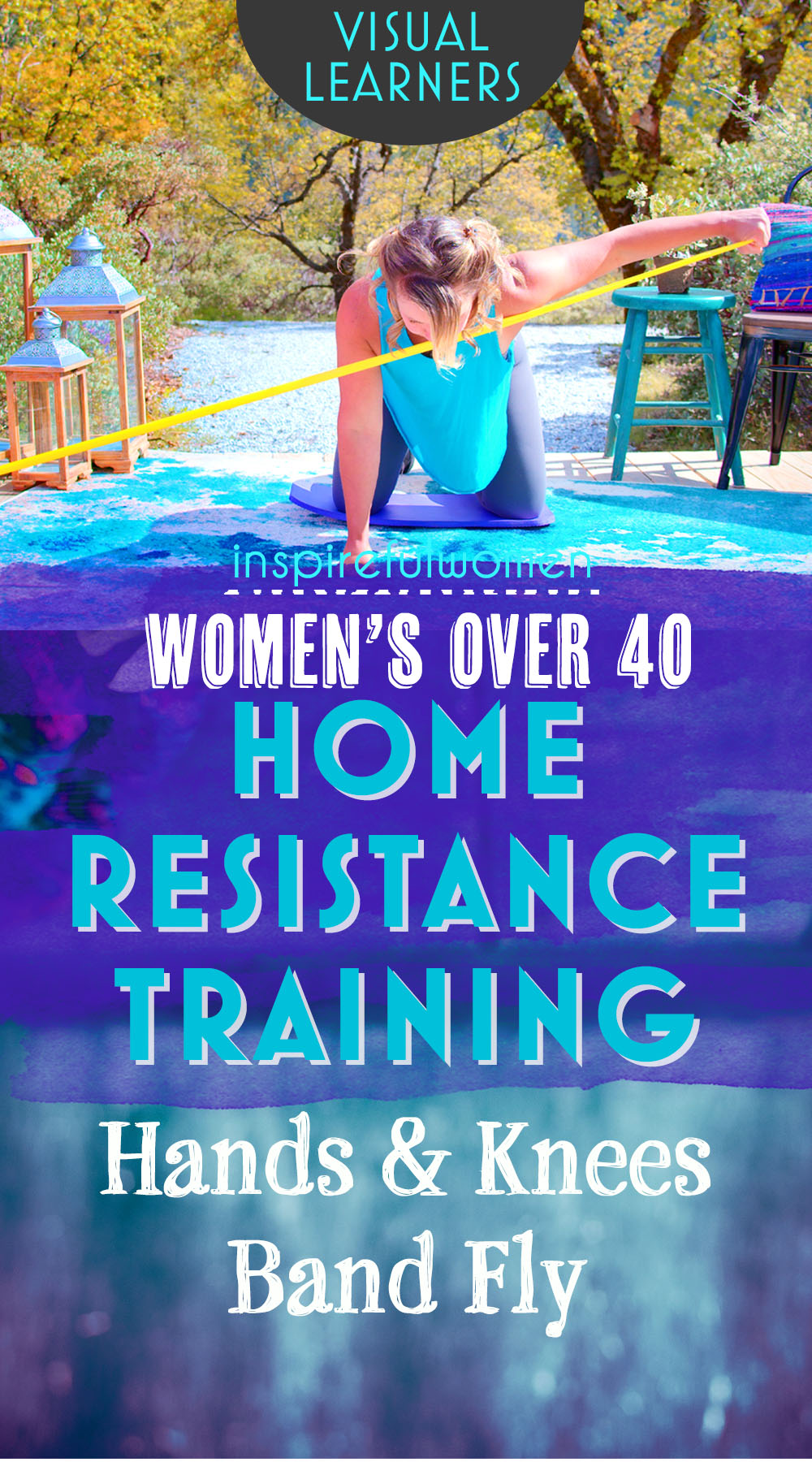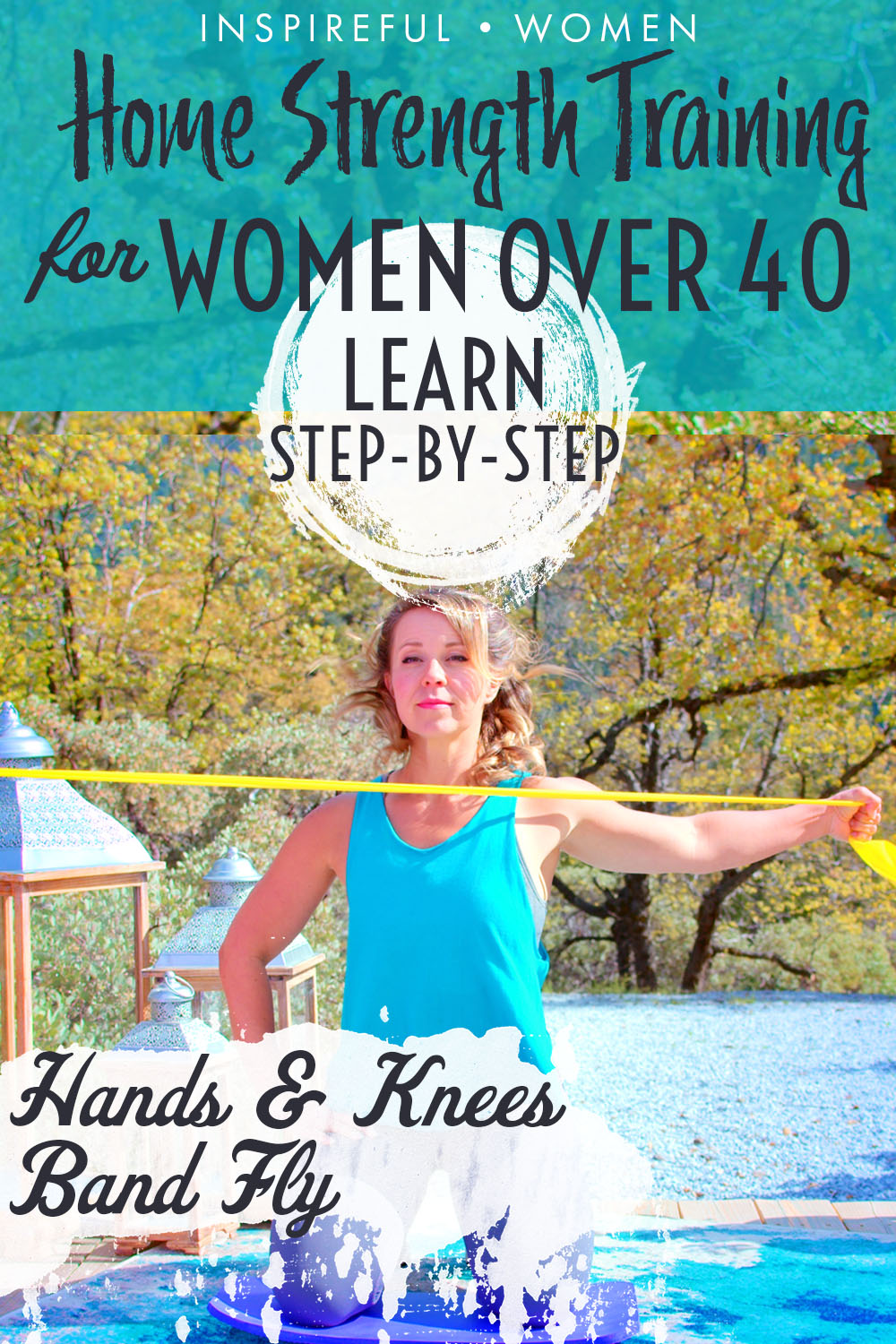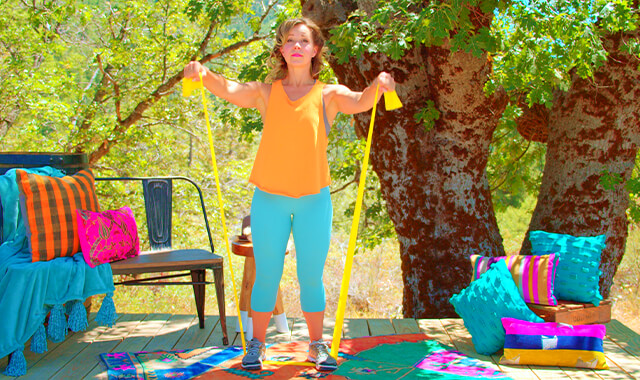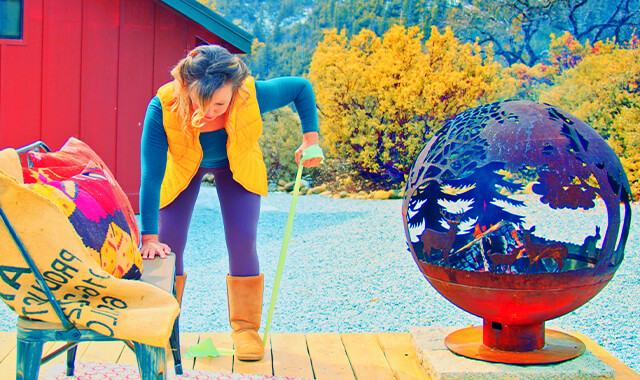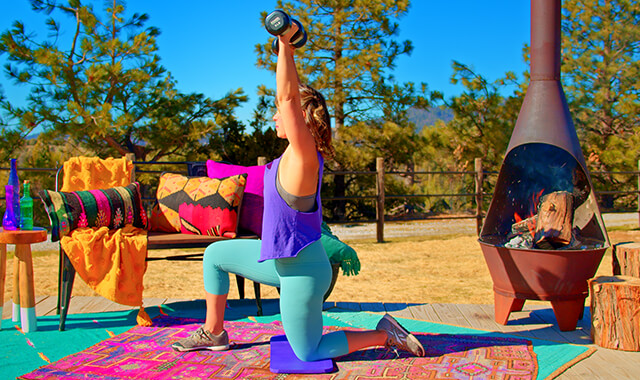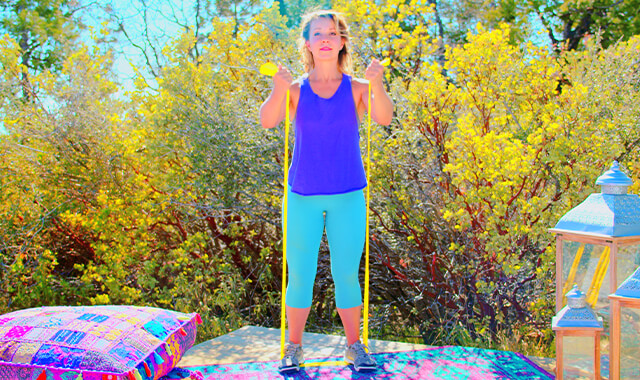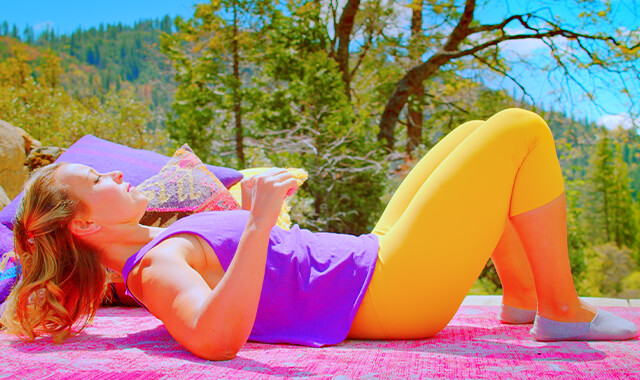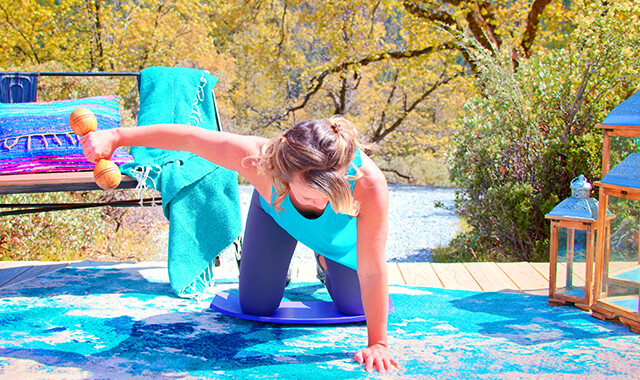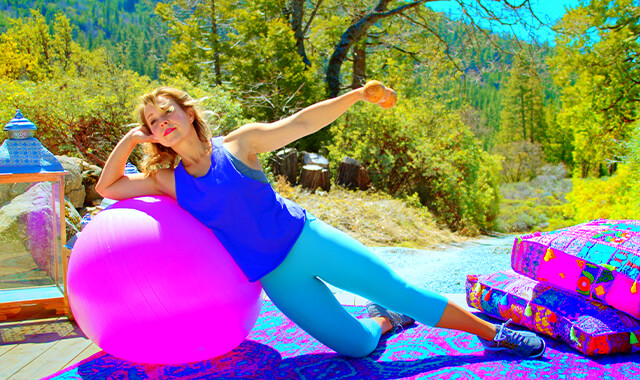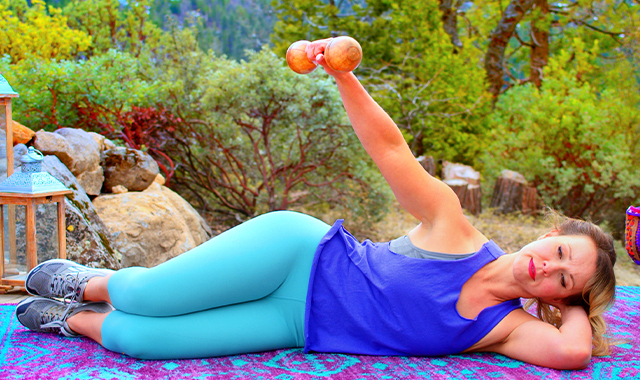Rear delt Band Fly variation
How to Do the Quadruped Rear Delt Band Fly - Wall Anchored | In-Depth Guide [VISUAL LEARNERS] Intermediate
Proper Form, Common Mistakes, & Variations | Home Resistance Training
WHAT DO YOU WANT TO SEE?
QUICK DEMO
QUICK DEMO
MUSCLES THIS WORKS
MUSCLES
MAIN MUSCLES WORKED IN The H&K Rear Delt Band Fly - Wall Anchored
REAR DELTOID
OTHER MUSCLES WORKED:
- Mid and lower trapezius
- Rhomboids
- Latissimus dorsi
- Serratus anterior
- Pectoralis
- Lateral deltoid
STARTING POINTERS
Starting Pointers
WHAT WE'RE DOING TODAY
Other names for this exercise: Quadruped Rear Deltoid Raise, Floor Rear Delt Fly
ALL WE'RE DOING:
On hands and knees, you'll take one arm out to your side.
This one might look a little intimidating, but I personally feel it's a fun position to work our rear delt in. And we get some core stabilization work while we're at it! It's perfect if you only have a low place to anchor a band too. You can do this exact same movement with the band anchored to your other hand if you don't want to bother mounting your long band somewhere- that's here.
This exercise works the rear portion of the deltoid muscle and has the bonus of also working the shoulder and arm that is on the floor. The arm on the floor is supporting some of your weight - this works all of the muscles of the shoulder joint at the same time (co-contraction) to keep the shoulder stable and to train the proprioceptors of the joint (the receptors that communicate with the brain so that it knows where the arm is). Weight-bearing exercises are very good for stimulating bone growth, especially for individuals with/or at risk of osteopenia or osteoporosis (low bone density). The hands and knees deltoid raise also work the muscles that stabilize the back and hips.
This exercise works most of the muscles that move and stabilize the shoulder blades as the arms move. The muscles are worked on both sides but each side in a different way. The arm on the floor works to hold the body still (static stability) and the other arm moves. The muscles around the shoulder blade of the working arm works to hold the shoulder blade still as the arm moves in the socket. This version of the rear delt raise focuses on shoulder extension, but does not target shoulder external rotation.
The use of the band will work the rear deltoid more the higher the arm is raised.
HOW TO DO THE EXERCISE
LOOKS
HOW The Wall Hands & Knees Band Fly SHAPE OUR BODY
Toned, balanced, capped shoulders, good posture.
PROPER FORM
PROPER FORM: Hands & Knees Band Fly - Wall Anchored
EQUIPMENT, SETS & REPS
EQUIPMENT
Main set (3: Light/Med/Heavy)
X-Heavy Band (I recommend getting this too if you plan to use resistance bands frequently).
SUGGESTED STARTING WEIGHT FOR WOMEN:
Light to moderate resistance bands
SETS & REPS:
2 sets of 8 reps
PACE:
Moderate lift up - with control and back stability, and slow controlled return to start.
WAYS TO ADJUST RESISTANCE FOR BANDS:
- Double them up - fold them over or use two.
- Shorten or lengthen them.
BODY POSITION
BODY POSITION FOR THE H&K Rear Delt Band Fly - Wall Anchored
BAND: Resistance band anchored low - close to the floor, on the side opposite of the working side - if you will be starting with your right arm then the band is anchored to your left side. Position your body so that the band is in line with your shoulder. The band will travel just in front of your hand that is on the floor.
BODY POSITION: Hands and knees (4-point, quadruped). Neutral spine, abdominals activated. Weight is equally distributed through both hands and knees. A good hands and knees position is like the beginning of a push-up - sternum lifted, chest open, shoulder blades together, and down your back. Your back should be level - if you put a tea cup filled with water on your upper back, it would not spill.
ARMS: Directly under shoulders, hand flat, fingers pointed forwards. Arms near straight - can have a slight bend at the elbow if that is more comfortable. If this position hurts your wrist you can do this with your hand fisted. Lift the working hand off of the floor to make sure the position feels ok when you are stabilizing with just one arm, as you will be in the exercise. Reach under your body and across to grab the band with your working arm. The band will travel just in front of the forearm of your nonworking arm.
HAND/GRIP: Pronated grip on band (this means your palm, in the hands and knees position, is facing behind you.
Position your knees directly under your hips. The top of your foot is resting on the floor, toes pointing back (it is fine to have the ankle dorsiflexed and the toes on the floor if that is more comfortable). Check to make sure that your thighs are straight up and down (vertical, perpendicular to the floor). Hips are bent to 90 degrees, knees are bent to 90 degrees.
NECK: Neutral and relaxed. Neck lengthened, eyes down.
HOW TO DO
HOW TO DO the Floor Rear Delt Band Fly - Wall Anchored
CUE: Focus on keeping your torso still and only moving through your shoulder joint.
Lift your working arm, pulling the band straight out to the side. Keep lifting it up, your arm will be parallel to the floor. Pull your arm back (behind your body) a bit more if you are able to. Hold the end position and pause.
Slowly lower your arm back down again, with the focus on isolating the movement to your shoulder joint.
When lowering your arm back down, stop before your working hand touches the floor - this will keep some tension on the band.
Begin the next rep.
When you have completed the desired number of reps, from the starting position, release the band. Turn around to work the other side.
HOW TO SAFELY GET OUT OF THE EXERCISE
From the starting position, release the band.
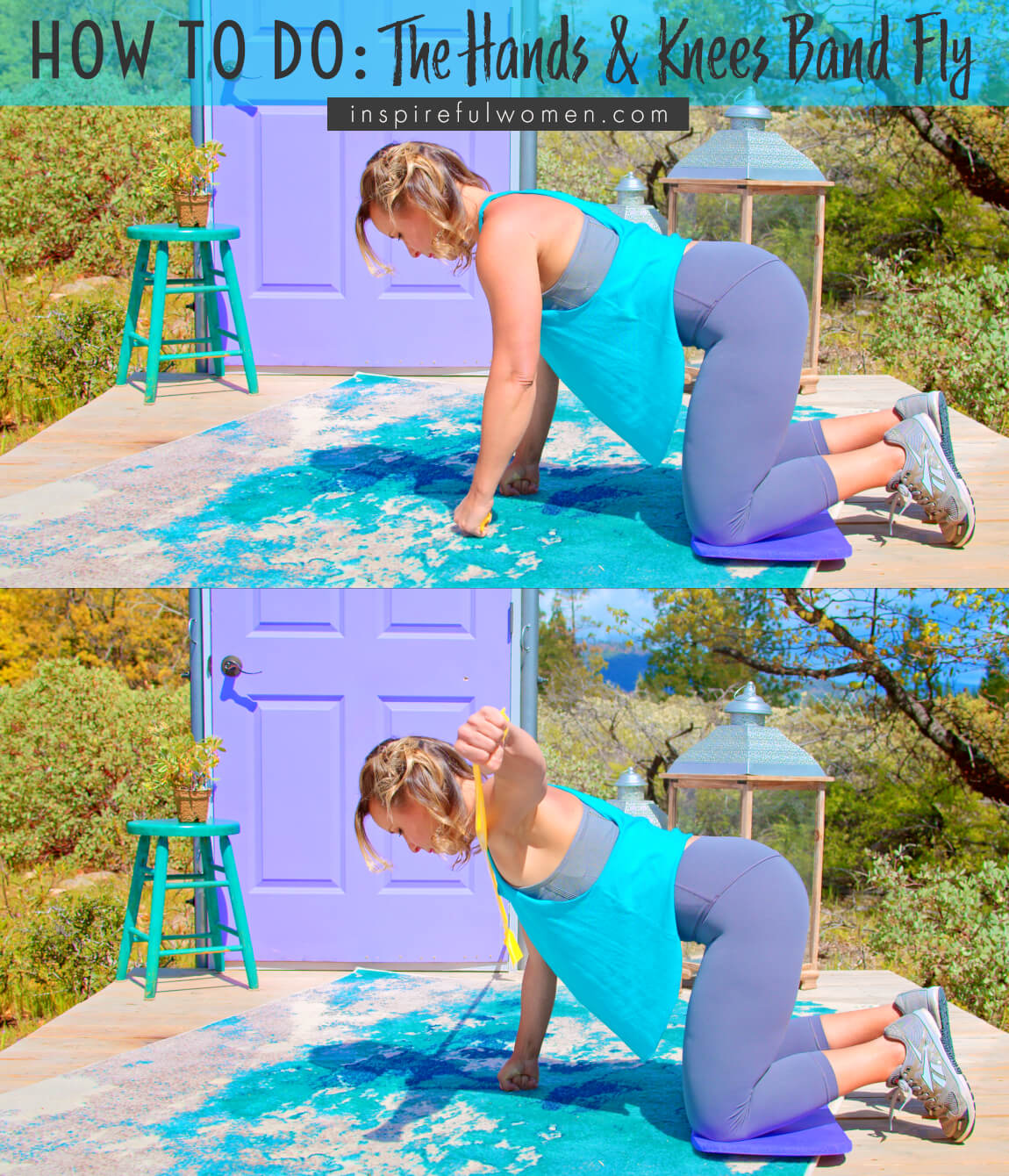

COMMON MISTAKES
COMMON MISTAKES
WHAT TO AVOID WITH THE Quadruped Rear Delt Band Fly - Wall Anchored
KEY TIP:
Guess what? Good news! Many avoids are the same for most movements. Once you learn the basics, there's really only a few extra avoids for each individual movement.
1. Avoid Arching Low Back
AVOID: Arching your low back.
WHY NOT?
- Pressure or discomfort in your low back.
- Can cause low back joint injury, muscle strain, or damage over time.
WHAT TO DO:
- Troubleshooting suggested fixes
- Poor core strength: activate your abdominal muscles, or choose a position with more support.

2. Avoid Rounding Low Back
AVOID: Rounding (flexing) your back.
WHY NOT?
- Can lead to muscle strain or low back joint injury.
- Will decrease the activation of the targeted muscles.
WHAT TO DO:
- Maintain a neutral spine position.
- This can be a result of poor back extensor strength
- Choose a position with more support.
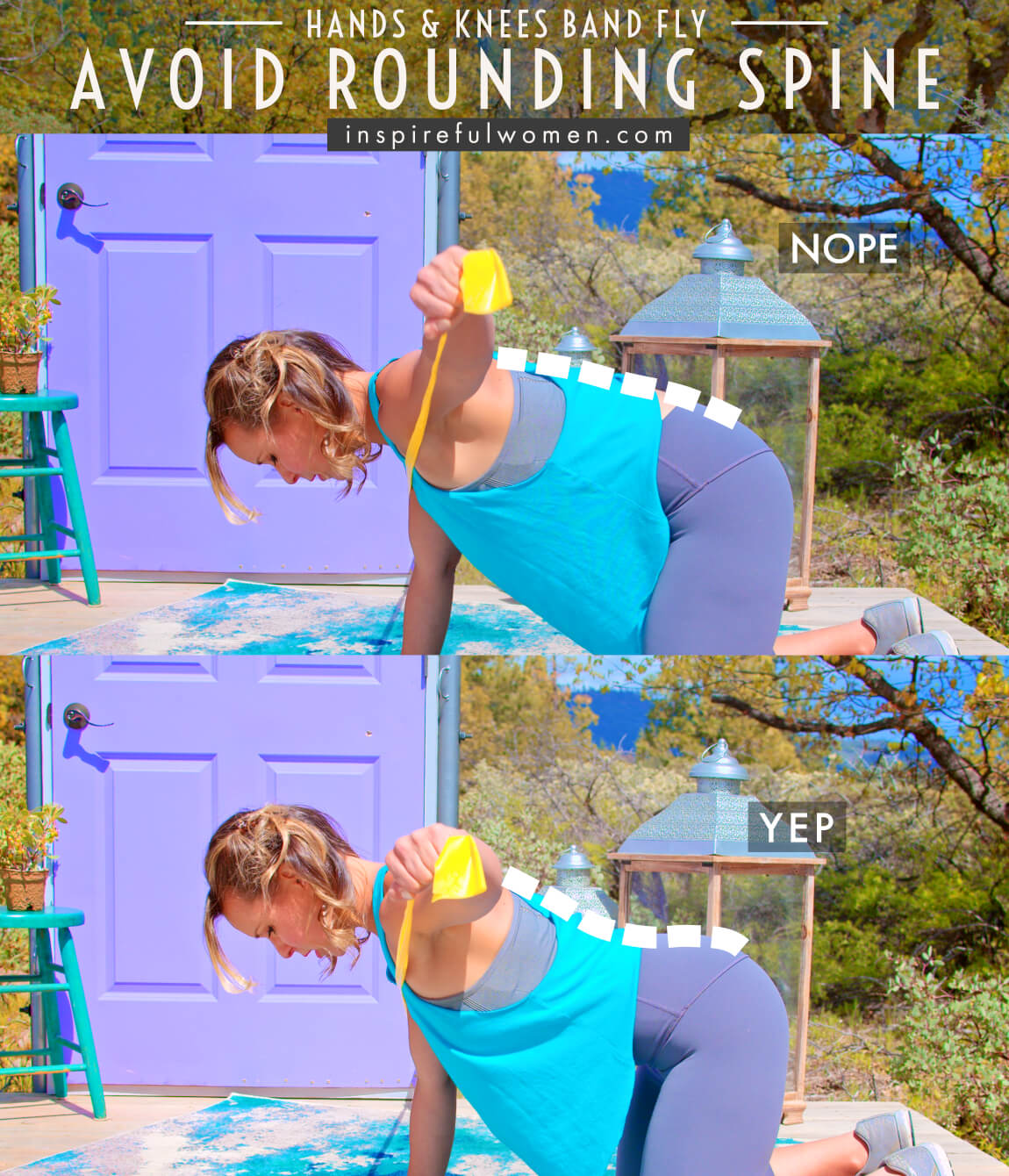
3. Avoid Rotating Upper Back
AVOID: Rotating your upper back instead of retracting the shoulder blade or extending the arm
WHY NOT?
- This would decrease the muscle activity of the scapular retractors and the rear deltoid.
WHAT TO DO:
- Keep your upper body facing forward, shoulders squared
- Concentrate on feeling the shoulder blade move back and then the arm move back.
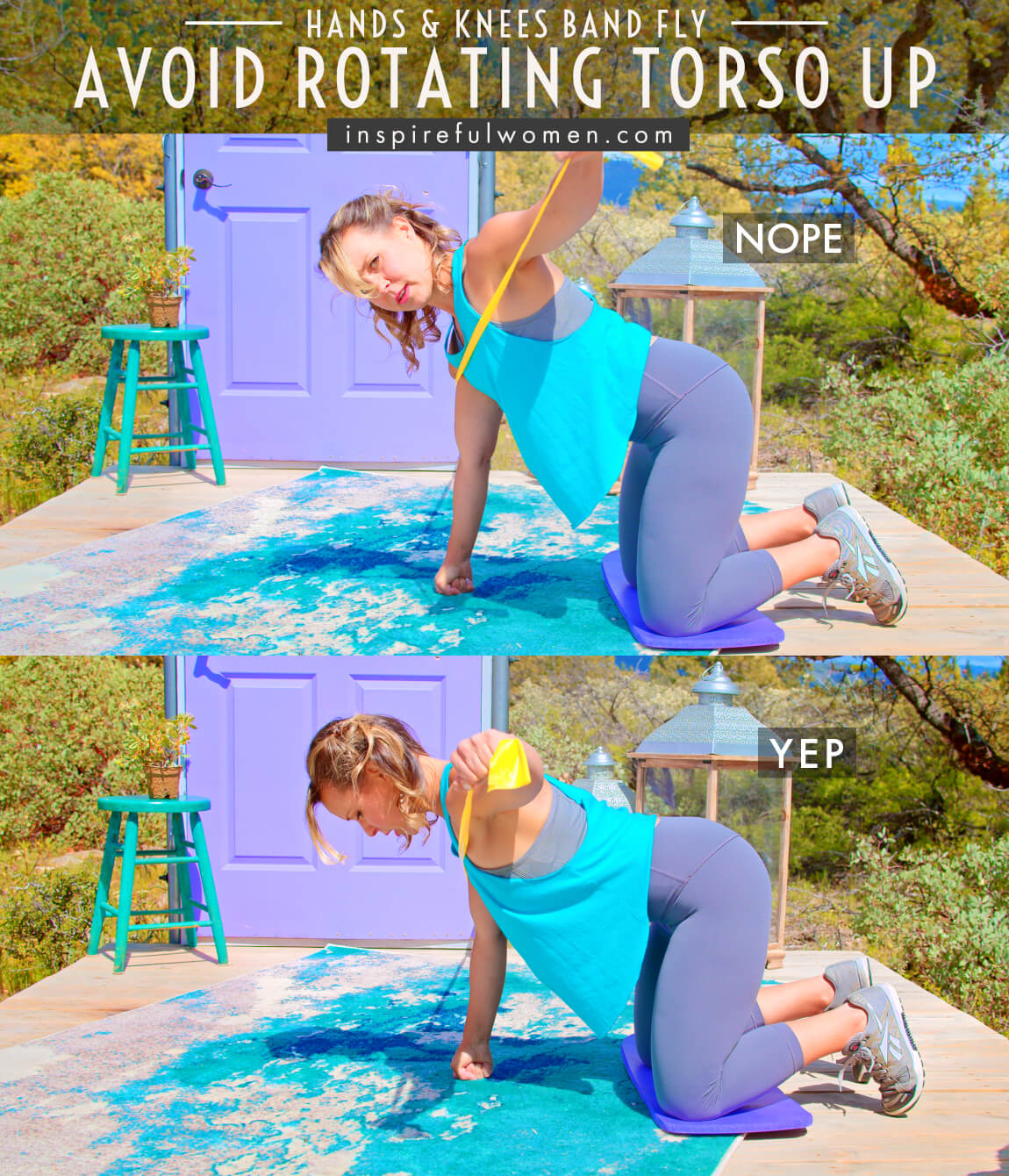
4. Avoid Leaning to One Side
AVOID: Leaning to one side.
WHAT TO DO:
- Torso should be level with your weight evenly distributed on both legs.
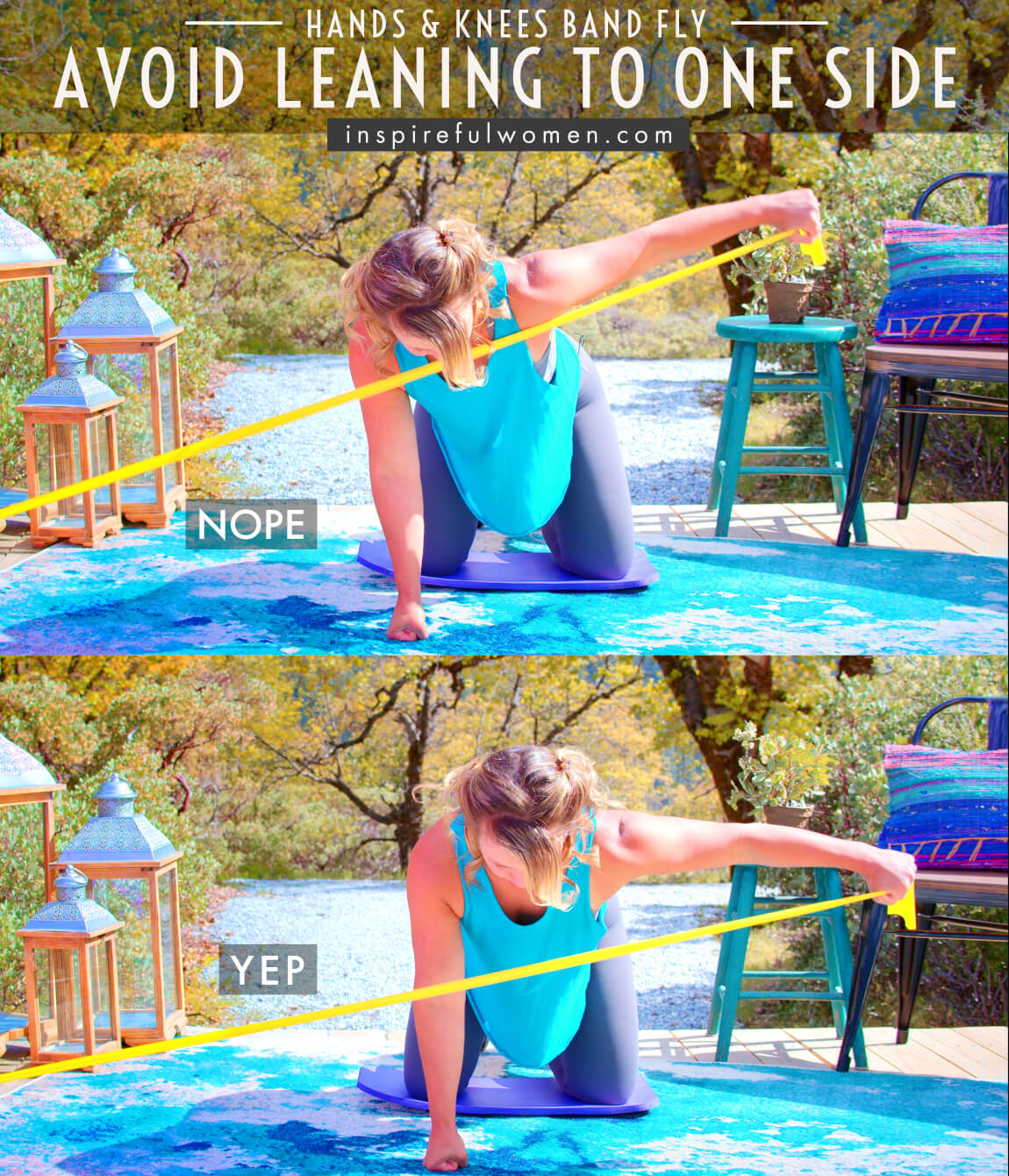
5. Avoid Too Much Resistance
AVOID: Too much resistance.
WHY NOT:
- The deltoid will become most active towards the end of the movement when the upper arm is behind your shoulder joint. Increasing the weight may prevent you from being able to get to this position.
- Increasing the weight can put too much strain on the front of the shoulder joint at the end of its range of shoulder extension.
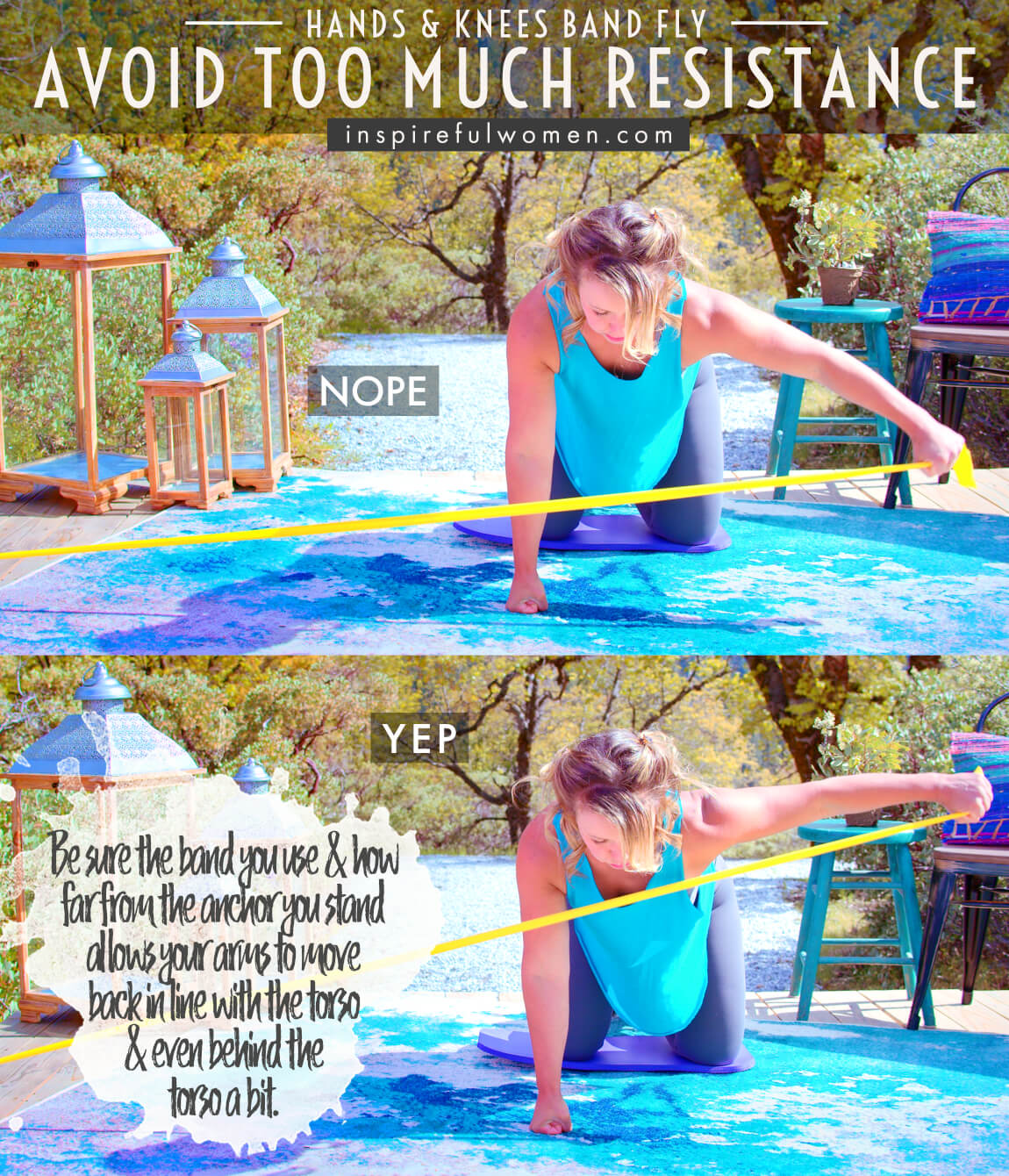
VARIATIONS
VARIATIONS
VARIATIONS OF the Hands & Knees Band Fly - Wall Anchored
Kneeling
Kneeling Rear Delt Fly
If putting your weight on your non-working arm/wrist is not comfortable - lift your non- working arm up off of the floor and move your torso back into a kneeling (not tall kneeling, your hips can be hinged). Your non-working arm can be placed behind your back or you can put your hand on your thigh. This position will eliminate the weight bearing benefits of your hands and knees position - (through your non working arm) and will decrease the work of the gluteals.
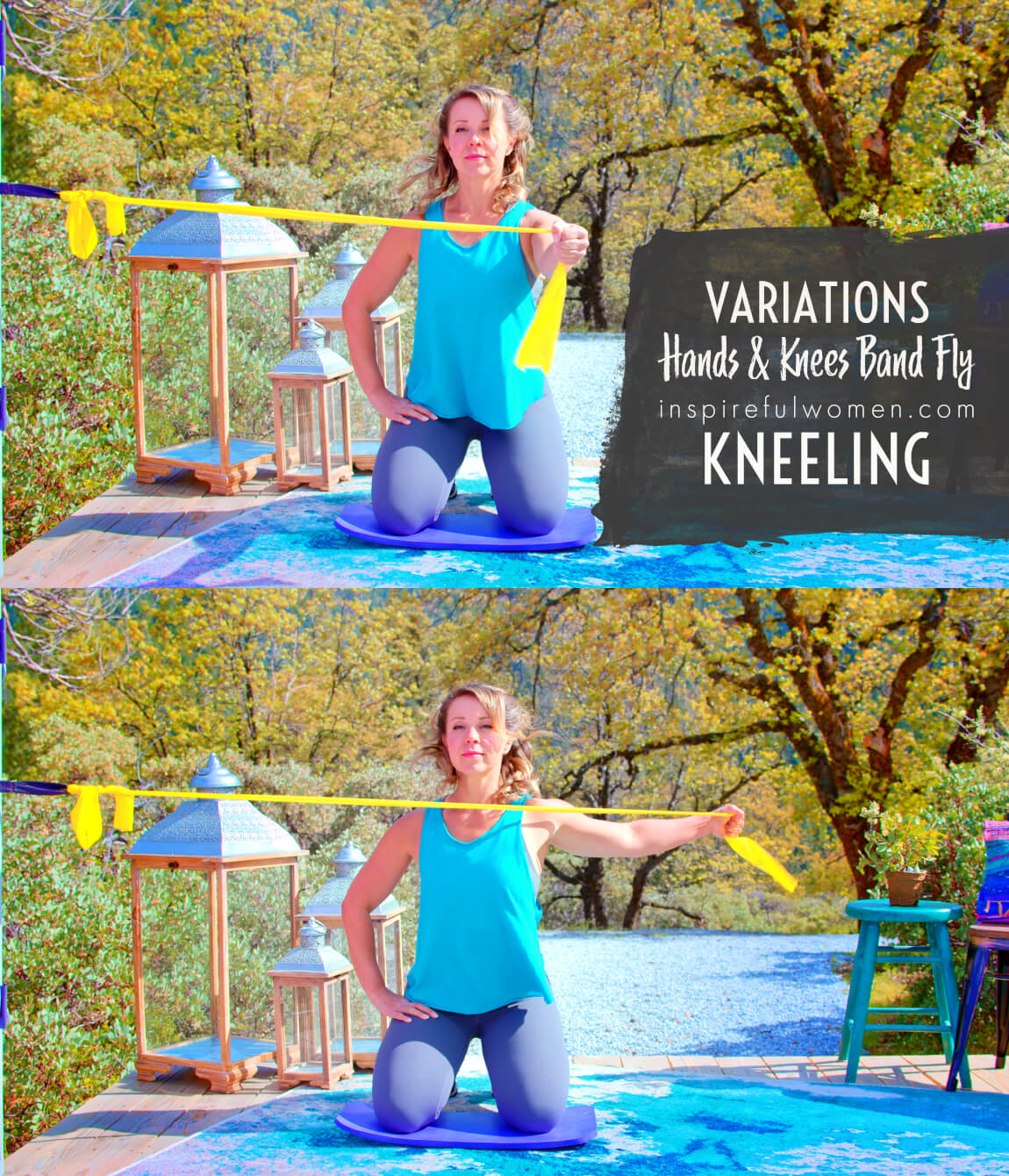
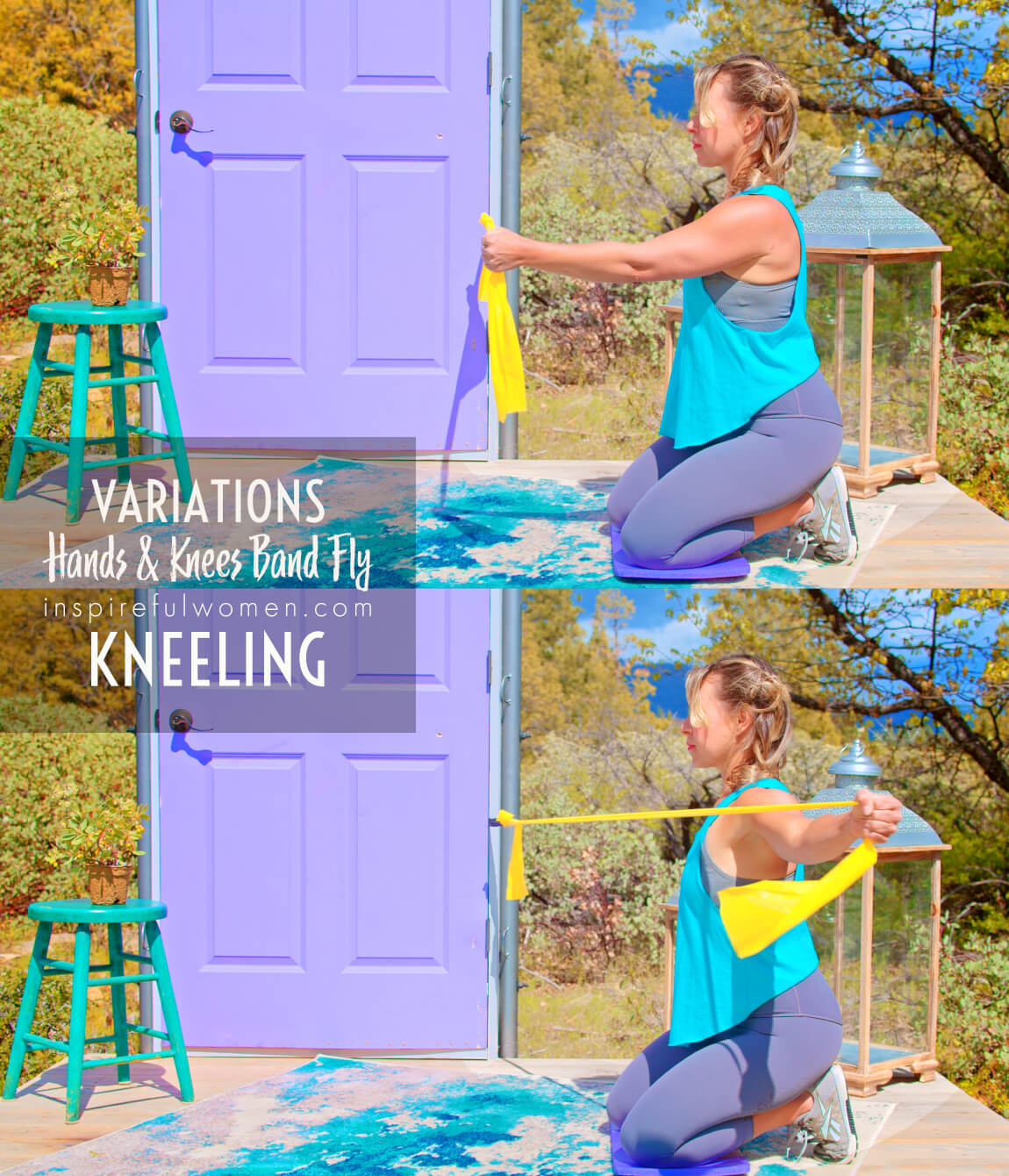
WHAT WE'RE DOING TODAY
WHAT & WHY
BENEFITS OF TRAINING THE Rear Delt
WHAT
The Rear Deltoid Fly works the muscle on the back of the shoulder. To target the rear (or posterior) part of the deltoid muscle the arm is lifted up to about the level of the shoulder and moved back, and slightly behind the torso.
Something I like about this exercise is it's one of the few exercise to work the back of our shoulder in a standing position. Why is this great? Because being bent over is a more challenging position for our body to hold! Nice to have a break once in awhile.
This exercise is a nice change from the movements that move the arm forwards or up. The backward movement of the arm works many of the muscles of the upper back, and moving the straight arm back will stretch the muscles on the front of the chest and the biceps. This feels good after sitting at a computer all day - it can be used to loosen up knots in your upper back by increasing blood flow to the area.
WHY BOTHER DOING IT?
WHY
WHY DO WE EVEN CARE?
THE BACK OF THE SHOULDER MATTERS TOO
The muscles on the back of the upper body are frequently overlooked in exercise programs. A lot of time is spent on exercises that involve lifting the arms up, pushing them forward, and pulling them down. It is important to include exercises that target the muscles of the back of the body in order to balance out the exercises that focus on the muscles in the front of the body.
Some of the most important muscles of the upper body are the muscles that attach to the shoulder blades (of which the rear or posterior delt is one). These muscles are responsible for keeping the shoulders healthy, the ability to move your arm through its full range, and hold you in upright posture. Overworking the muscles on the front of the body and underworking the muscles on the back of the body can lead to a stooped posture, upper back, neck and shoulder pain.
It is extremely rare that we only use one muscle at a time. Most movements involve many muscles working in coordination. This is especially true for movements of the arm. The main job of the shoulder is to move and position the hand. Moving the arm involves coordination between the arm and the shoulder blade. This exercise is good for targeting the muscles that control the movements of the arm and the shoulder blade and training them to work together for healthy arm movement.
EVERYDAY LIFE
EVERYDAY LIFE &
MUSCLE FUNCTION
HOW WE USE OUR rear deltoid IN EVERYDAY LIFE
1. REACHING BEHIND THE BODY
- Tending a kid in the back seat
- Reaching into the back pocket
- Bringing the arm back to throw a ball (overhand)
2. PULLING
- Pulling a car door shut
- Pulling a refrigerator door open
3. ROTATING THE UPPER ARM SO THAT THE SOFT UNDERSIDE IS FACING FORWARD AND/OR UP (EXTERNAL ROTATION)
- Reaching the back of your head for washing, brushing your hair
- Pulling a shirt off over your head
- Reaching the top of a zipper
- Scratching your upper back
- Turning your outstretched arm with the palm up (need shoulder external rotation and forearm supination)
- Receiving change in the palm of the hand
4. WORKS WITH THE ANTERIOR, AND MIDDLE FIBERS OF THE DELTOID TO STABILIZE THE SHOULDER JOINT DURING ALL ARM MOVEMENTS.
- Improves the ability to lift and carry heavy objects (the arm has a stable base to work off of).
- Injury prevention
HOW TO FEEL WHAT MUSCLE IS WORKING
How to Feel What Muscle is Working
Take your opposite hand and place it on top of your shoulder. You should feel a hard, flat surface right on top close to the shoulder joint. That is part of the shoulder blade called the acromion process. Drop your fingers right below the bony ridge. Hold your upper arm up out to the side a little more than halfway between being right by your side and being at shoulder level (approximately 50 - 60 degrees of abduction) with the elbow bent. Push the upper arm back. You should feel the rear fibers of the deltoid activate under your fingers. It can help to push your elbow into the back of the chair or a wall.
SCIENCY STUFF
SCIENCY STUFF
SPIFFILICIOUS FACTS ABOUT MUSCLES & MOVES
The rear portion of the deltoid originates on the scapula (shoulder blade), crosses the shoulder joint at the back and attaches on the humerus (upper arm bone). The muscle moves the arm back from being in front of the body and externally rotates the arm. It is most active when the arm is lifted out to the side and away from the body (in abduction - so the arm is moving closer to horizontal abduction and extension).
ALLLL MUSCLES & WHEN
ALL MUSCLES WORKING & WHEN DURING THE Hands & Knees Band Fly - Wall Anchored
In the beginning position, the core stabilizers ( internal and external obliques, quadratus lumborum, psoas major, rectus abdominis, erector spinae, multifidi, transverse abdominis) hold the spine in a neutral position.
The hands and knees position uses the muscles surrounding and stabilizing the hip joints (hamstrings, quads, hip abductors and adductors, internal and external rotators). For this exercise, one arm is on the floor and the other arm (the working arm) is off of the floor. Supporting the upper body on one side only will cause a rotational force on the torso, the obliques and quadratus lumborum will work to hold the torso level and stable.
The muscles of the weight-bearing arm (the arm on the floor) are co-contracting (contracting at the same time isometrically) to stabilize the shoulder blade and shoulder joint; these muscles include the biceps, triceps, rotator cuff (supraspinatus, infraspinatus, subscapularis, teres minor), latissimus dorsi, trapezius, rhomboids, serratus anterior, pectoralis, deltoids. The muscles of the arm will work isometrically to hold the elbow and wrist stable.
The posterior deltoid and lateral deltoid (will help to vary degrees depending on the exact positioning of band and amount of resistance used) contracts concentrically to lift the arm up and out to the side (from the floor out to the side - 90 degrees of abduction). The arm will be parallel to the floor and to the side, and will move slightly backwards (up towards the ceiling). The triceps works isometrically to hold the elbow in extension.
The deltoid works eccentrically to lower the arm back to the beginning position for the next rep.
PIN IT FOR LATER!
